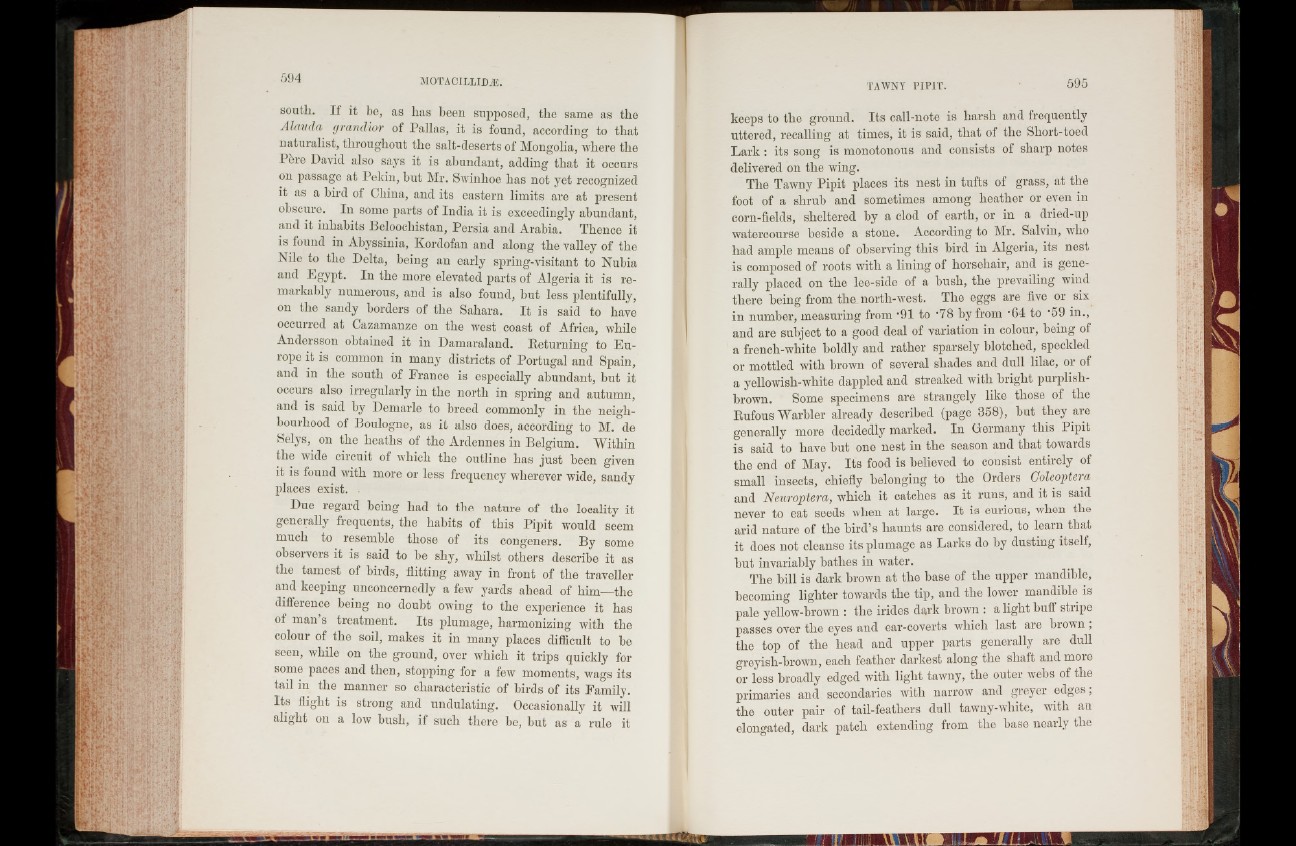
south. If it be, as has been supposed, the same as the
Alauda grandior of Pallas, it is found, according to that
naturalist, throughout the salt-deserts of Mongolia, where the
I ere David also says it is abundant, adding that it occurs
on passage at Pekin, but Mr. Swinhoe has not yet recognized
it as a bird of China, and its eastern limits are at present
obscure. In some parts of India it is exceedingly abundant,
and it inhabits Beloocliistan, Persia and Arabia. Thence it
is found in Abyssinia, Kordofan and along the valley of the
Nile to the Delta, being an early spring-visitant to Nubia
and Egypt. In the more elevated parts of Algeria it is remarkably
numerous, and is also found, but less plentifully,
on the sandy borders of the Sahara. I t is said to have
occurred at Cazamanze on the west coast of Africa, while
Andersson obtained it in Damaraland. Returning to E u rope
it is common in many districts of Portugal and Spain,
and in the south of France is especially abundant, but it
occurs also irregularly in the north in spring and autumn,
and is said by Demarle to breed commonly in the neighbourhood
of Boulogne, as it also does, according to M. de
Selys, 011 the heaths of the Ardennes in Belgium. Within
the wide circuit of which the outline has just been given
it is found with more or less frequency wherever wide, sandy
places exist.
Due regard being had to the nature of the locality it
geneially frequents, the habits of this Pipit would seem
much to resemble those of its congeners. By some
observers it is said to be shy, whilst others describe it as
the tamest of birds, hitting away in front of the traveller
and keeping unconcernedly a few yards ahead of him—the
difference being no doubt owing to the experience it has
of man s treatment. Its plumage, harmonizing with the
colour of the soil, makes it in many places difficult to be
seen, while on the ground, over which it trips quickly for
some paces and then, stopping for a few moments, wags its
tail in the manner so characteristic of birds of its Family.
Its flight is strong and undulating. Occasionally it will
alight on a low bush, if such there be, but as a rule it
keeps to the ground. Its call-note is harsh and frequently
uttered, recalling at times, it is said, that of the Short-toed
Lark : its song is monotonous and consists of sharp notes
delivered on the wing.
The Tawny Pipit places its nest in tufts of grass, at the
foot of a shrub and sometimes among heather or even in
corn-fields, sheltered by a clod of earth, or in a dried-up
watercourse beside a stone. According to Mr. Salvin, who
had ample means of observing this bird in Algeria, its nest
is composed of roots with a lining of horsehair, and is generally
placed on the lee-side of a bush, the prevailing wind
there being from the north-west. The eggs are five or six
in number, measuring from ’91 to -78 by from ’64 to ‘59 in.,
and are subject to a good deal of variation in colour, being ol
a french-white boldly and rather sparsely blotched, speckled
or mottled with brown of several shades and dull lilac, or of
a yellowish-white dappled and streaked with bright purplish-
brown. Some specimens are strangely like those of the
Rufous Warbler already described (page 358), but they are
generally more decidedly marked. In Germany this Pipit
is said to have but one nest in the season and that towards
the end of May. Its food is believed to consist entirely of
small insects, chiefly belonging to the Orders Coleóptera
and Neuroptera, which it catches as it runs, and it is said
never to eat seeds when at large. It is curious, when the
arid nature of the bird’s haunts are considered, to learn that
it does not cleanse its plumage as Larks do by dusting itself,
but invariably bathes in water.
The bill is dark brown at the base of the upper mandible,
becoming lighter towards the tip, and the lower mandible is
pale yellow-brown : the irides dark brown : a light buff stripe
passes over the eyes and ear-coverts which last are biown ;
the top of the head and upper parts generally are dull
greyish-brown, each feather darkest along the shaft and moio
or less broadly edged with light tawny, the outer webs of the
primaries and secondaries with narrow and greyer edges;
the outer pair of tail-feathers dull tawny-white, with an
elongated, dark patch extending from the base neaily the